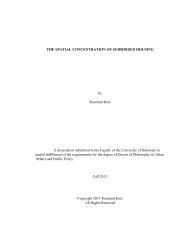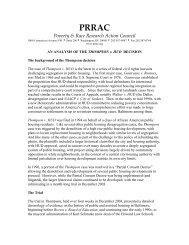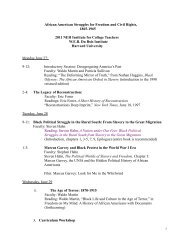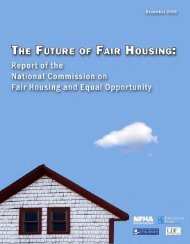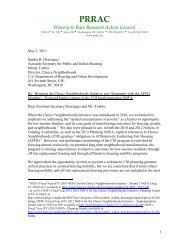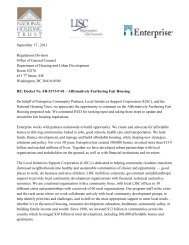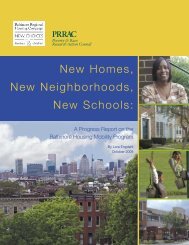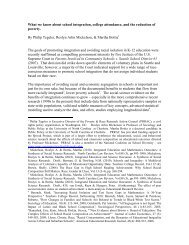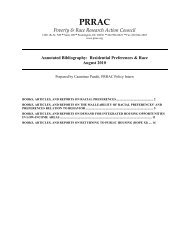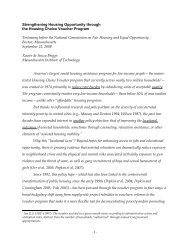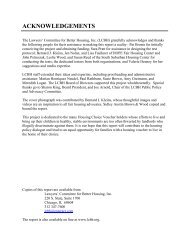Annotated Bibliography of Housing Mobility Research 2006-2010
Annotated Bibliography of Housing Mobility Research 2006-2010
Annotated Bibliography of Housing Mobility Research 2006-2010
You also want an ePaper? Increase the reach of your titles
YUMPU automatically turns print PDFs into web optimized ePapers that Google loves.
developments that are becoming increasingly dangerous and chaotic as vacancies increase.<br />
Goetz, Edward G., “Better Neighborhoods, Better Outcomes Explaining Relocation Outcomes<br />
in HOPE VI,” Cityscape 12:1 (<strong>2010</strong>)<br />
Highlights:<br />
Abstract:<br />
· Concludes that the degree <strong>of</strong> neighborhood change is not statistically related to changes in<br />
individuallevel outcomes for economic selfsufficiency or access to enhanced social capital<br />
· No significant educational achievement improvements for children and no improvement in<br />
employment or financial security; possibly due to destroyed support networks<br />
· Similarly, Duluth case study shows little to no improvement on subjective individuallevel<br />
measures, despite moving to objectively better neighborhoods<br />
· Highlights importance <strong>of</strong> individual characteristics like age,<br />
Previous studies have shown weak and inconsistent benefits for families forcibly displaced by the<br />
HOPE VI program, despite the fact that families are uniformly moved into better neighborhoods<br />
(as measured on a range <strong>of</strong> indicators at the censustract level). This article reviews studies <strong>of</strong><br />
HOPE VI and presents the findings <strong>of</strong> an additional case study, in Duluth, Minnesota. Improving<br />
on the design <strong>of</strong> most previous studies, this study connected changes in outcomes at the individual<br />
level with changes in neighborhood conditions. The results confirm the conclusion <strong>of</strong> previous<br />
studies: the degree <strong>of</strong> neighborhood change is not statistically related to changes in individual level<br />
outcomes. These findings suggest that the Hope VI model <strong>of</strong> dispersal reflects an oversimplified<br />
view <strong>of</strong> urban poverty and, in particular, may neglect the importance <strong>of</strong> informal networks <strong>of</strong><br />
support and attributes at the individual level in determining the outcomes <strong>of</strong> forced relocation.<br />
Johnson, Heidi, “Vulnerable Youth and the Transition to Adulthood: Youth in Distressed<br />
Neighborhoods, ASPE <strong>Research</strong> Brief,” Urban Institute (2009). Available at:<br />
http://www.urban.org/uploadedpdf/411948_distressed_neighborhoods.pdf<br />
Highlights:<br />
Abstract:<br />
· 10% <strong>of</strong> youth from distressed neighborhoods have sex before age 13 compared with 3% from<br />
nondistressed neighborhoods.<br />
· 32% <strong>of</strong> youth from distressed neighborhood do not earn a high school diploma compared with<br />
15% from nondistressed neighborhoods.<br />
· 65% <strong>of</strong> youth from distressed neighborhoods are employed on their 24 th birthday, compared<br />
with 78% from nondistressed neighborhoods.<br />
Fact sheet prepared by Heidi Johnson <strong>of</strong> the Urban Institute, under contract to ASPE, as part <strong>of</strong> a<br />
series on vulnerable youth and the transition to adulthood. This four page research brief uses data<br />
from the National Longitudinal Survey <strong>of</strong> Youth, 1997 cohort, to compare adolescent risk<br />
behaviors and young adult outcomes <strong>of</strong> youth from distressed neighborhoods with those <strong>of</strong> youth<br />
from nondistressed neighborhoods. The analyses in this series use the subset <strong>of</strong> youth born in<br />
1980–81, who were 15–17 years old when first interviewed in 1997. Outcomes are obtained by<br />
using the annual data through 2005 when these young adults were 23–25 years old. Finds that<br />
youth from distressed neighborhoods do not engage in more risk behaviors during adolescence<br />
than youth from nondistressed neighborhoods, in some cases resulting in lower rates <strong>of</strong><br />
participation in criminal activities. However, youth from distressed neighborhoods are more likely<br />
to have sex at young age and less likely to earn a high school diploma.<br />
Joseph, Mark L., “Creating mixedincome developments in Chicago: developer and service<br />
provider perspectives,” <strong>Housing</strong> Policy Debate, 20(1): 91118 (<strong>2010</strong>)<br />
Summary: Mixedincome development has been embraced by policymakers across the country as a promising<br />
means <strong>of</strong> deconcentrating poverty and revitalizing innercity neighborhoods. The unprecedented<br />
scale <strong>of</strong> Chicago’s effort at mixedincome development provides an important opportunity to learn<br />
24



